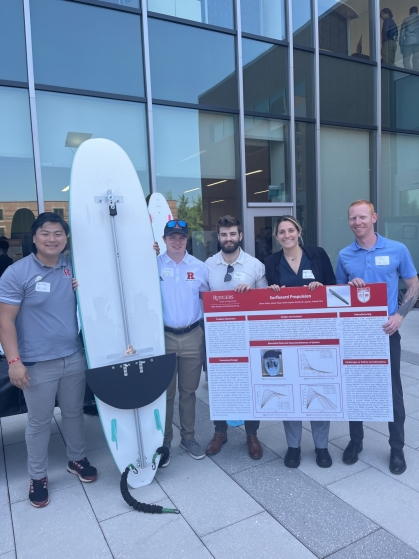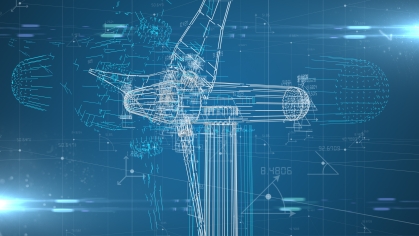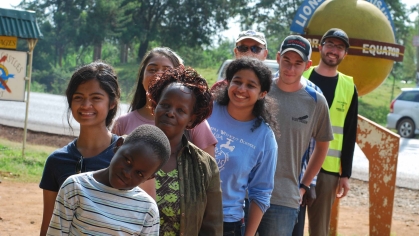Senior Design Project Catches the Wave
When three of the five mechanical and aerospace engineering majors on a senior design team are athletes, it’s no surprise that their project choice—a device designed to help surfers catch a wave – would make waves.

As senior Steven Coponi, a javelin thrower and Rutgers Track and Field captain, explains, “Often the most difficult part of surfing is being able to time and paddle fast enough to catch a wave. It’s almost universally observed that beginner surfers lack the confidence and ability to swim fast enough to catch a wave successfully – and it’s a learning curve that can take anywhere from one day to many years before they can catch quality waves.”
Coponi and fellow team members –track and field teammate Jin Choi; volleyball player Alyssa Nayar; Shane Willey who was working at NJ Natural Gas but is heading to NAVSEA; and Dominic Luppino, who works at an HVAC company – created a mechanical propulsion system that attaches under a surfboard, to “give the surfer an immediate and powerful boost. The higher acceleration achieved by our system is a crucial aspect of its effectiveness,” he says.
While he describes himself as the team’s concept and numbers cruncher, he credits its success to the fact that since it was composed of three athletes and two full-time workers, “everyone understood that we needed to be team players, especially since our schedules rarely lined up for us to be together at one time.”
From Paper Napkin Sketch to a Working Invention
According to Coponi, initial brainstorming the team concluded that since past groups undertaking this project under the guidance of Aaron Mazzeo, an associate professor in the Department of Mechanical and Aerospace Engineering, had relied on propellor-type designs that never made it to the beach or pool, it was time to learn from those mistakes and develop a mechanical propulsion system instead.
“I really enjoyed the development phase of the project – from bringing it from the paper napkin sketch to having real numbers that started to show us that our idea actually had a strong foundation to stand on,” he recalls. “To me, that’s always the best part of any project, but this one was special because when we look at the system, we know there is a lot more to it than what meets the eye. That’s something I’m very proud of.”
Keeping the Design Project Top of Mind
Coponi additionally reports that while the team had filed an invention disclosure on their design project with Rutgers that after team discussions, “we are planning to go ahead with a provisional patent while we optimize our system.”
As the recipient of the Rutgers Big 10 Conference Postgraduate Scholarship, Coponi will pursue his SoE MS in mechanical engineering in the fall, when he will reconnect with and help optimize the device. “There are a few things that I could continue to refine to make this project have incredible functionality. I think there is a surprisingly large market demand, so I’d definitely say that this project will live on through all my graduate studies.’’


